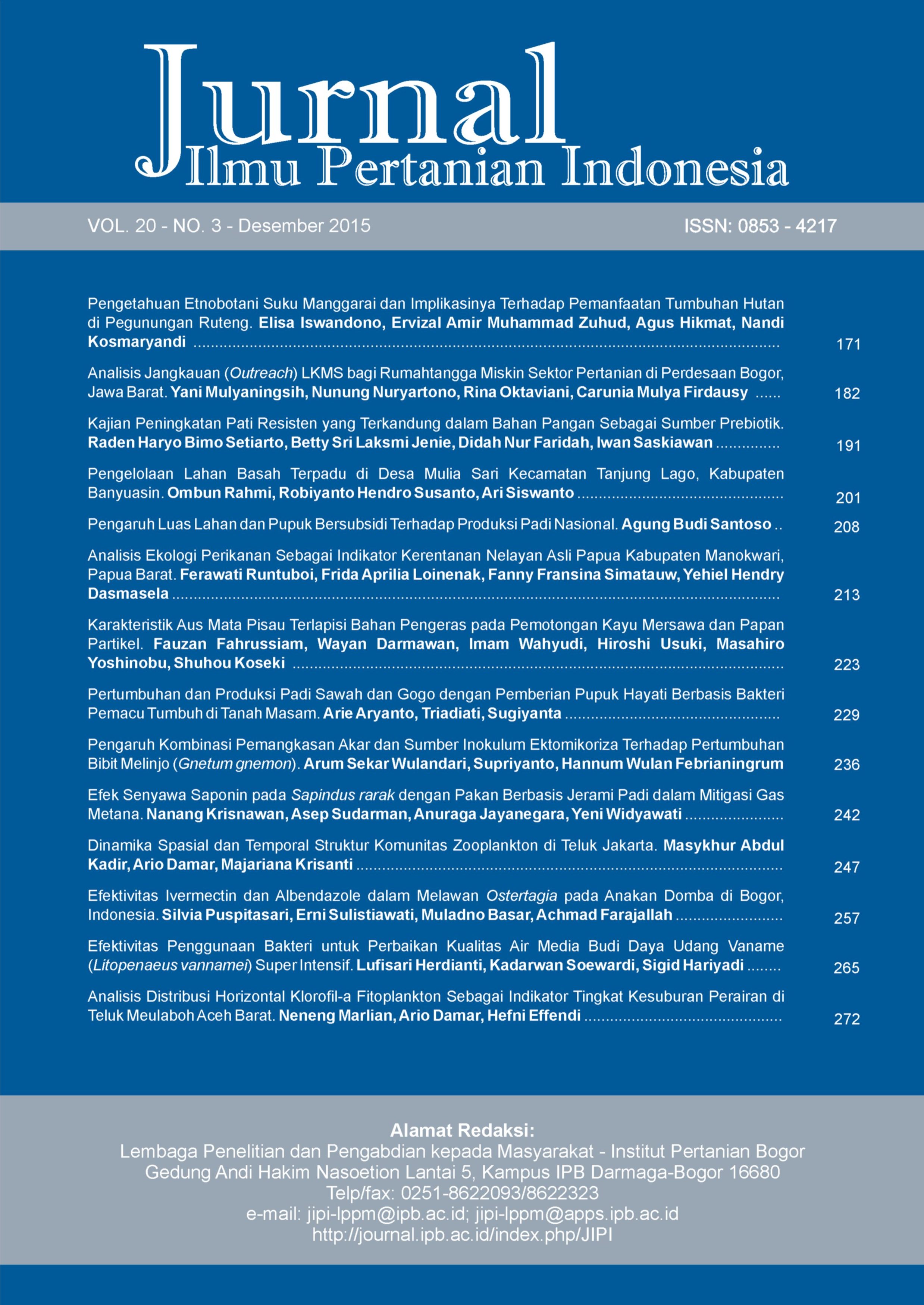Efektivitas Penggunaan Bakteri Untuk Perbaikan Kualitas Air Media Budi Daya Udang Vaname (Litopenaeus vannamei) Super Intensif
Abstract
Aquaculture activities in coastal area potentially produced wastes which leads water pollution. In order to reduce pollution, the use of several bacteria is very promising. This study was aimed to determine the effectivity of commercial bacterial inocculants to reduce pollution in cultured water. Bacterial inocculant tested in this study was SN®, SB®, and the combination of both inocculants for water quality improvements in white shrimp (Litopenaeus vannamei) super intensive culture media. This study was conducting in two steps, namely (i) preliminary study and (ii) primary study. The preliminary study was aimed to determine the time required to add bacteria based on the total number of bacterial colonies. The result showed that total colonies number of media treated with addition of SN® and SB® were reached maximum within 2 days. The result of primary study showed that the combination of SN® and SB® showed best effect in maintaining water quality of the culture media. This combination are proven reduces ammonia by 96%, nitrite-N by 83%, and COD by 42%.Downloads
References
Altschul SF, Madden TL, Schaffer AA, Zhang J, Zhang Z, Miller W, Lipman DJ. 1997. Gapped BLAST and PSI-BLAST: a new generation of protein database programs. Nucleic Acids Research. 25(7): 3389-3402. http://doi.org/d8t8f7
[APHA] American Public Health Association. 2005. Standard Method For The Examination Of Water And Waste Water: Water Pollution Control Federation. Port City (US): APHA.
[APHA] American Public Health Association. 2012. Standard Method For The Examination Of Water And Waste Water: Water Pollution Control Federation. Port City (US): APHA.
Atjo H. 2013. Budi daya udang vaname supra-intensif Indonesia. Dipresentasikan pada Launching Budi Daya Udang Vaname Super Intensif Indonesia. Barru, 24 Okt 2013. MAI-SCI Sulawesi Selatan (ID). 4 hal.
Badjoeri M, Widiyanto T. 2008. Penggunaan bakteri nitrifikasi untuk bioremediasi dan pengaruhnya terhadap konsentrasi amonia dan nitrit di tambak udang. Oseanografi dan Limnologi di Indonesia. 34(2): 261-278.
Balcazar JL, Venderell D, de Blas I, Ruiz-Zarzuela I, Muzquiz JL, Girones O. 2008. Chaacterization of probiotic properties of lactic acid bacteria isolated from intestinal microbiota of fish. Aquaculture. 278(1-4): 188-191. http://doi.org/b4wwfx
Browdy CL, Bratvold D, Hopkins JS, Stokes AD, Sandifer PA. 2001. Emerging technologies for mitigation of environmental impact associated with shrimp aquaculture pond effluents. Asian Fisheries Science. 14: 255-265.
De Rodriganez MAS, Diaz-Rosales P, Chabrillon M, Smidt H, Arijo S, Leon-Rubio JM, Alarcon FJ, Balebona MC, Morinigo MA, Cara JB, Moyano FJ. 2009. Effect of dietary administration of probiotics on growth and intestine functionality of juvenile Senegal sole (Solea senegalensis, Kaup (1858). Aquaculture Nutrition. 15(2): 177-185. http://doi.org/c424z2
Devaraja T, Banerjee S, Yusoff F, Shariff M, Khatoon H. 2013. A holistic approach for selection of Bacillus sp. As a bioremediator for shrimp postlarvae culture. Turkish Journal of Biology. 37: 92-100.
[FAO] Food and Agriculture Organization. 2000. Yearbook of fisheries statistics. Rome (IT): FAO.
Foon NGC. 2004. Effectiveness of Bacillus spp. on Ammonia reduction and Improvement of Water Quality in Shrimp Hatchery. [Thesis]. Serdang (MY): Universiti Putra Malaysia. hal.4.
Karigar CS, Rao SS. 2011. Role of microbial enzymes in bioremediation of pollutans: A review. Enzyme Research. 2011: 1-11. http://doi.org/bt8kvp
Martoharsono S. 2006. Biokimia 2. Yogyakarta (ID): Gadjah Mada University Press.
Mattjik AA, Sumertajaya IM. 2006. Perancangan Percobaan dengan Aplikasi SAS dan Minitab Jilid I. Edisi kedua. Bogor (ID): IPB-Press. Hal.86.
Moriarty DJW. 1984. Role of bacteria and meiofauna in the productivity of prawn aquaculture ponds. Proc.1st Internat.Conf. on the Culture of Penaeid Prawns/Shrimps, Dec. 4-7, Aquacul. Dept., California (US), pp: 47-64.
Pattukumar V, Sahu MK, Murugan M, Sethubathi GV, Sivakumar K, Arul V. 2010. Population of Vibrio parahaemolyticus (pathogen) and Bacillus (beneficial bacteria) in Penaeus monodon (Fabricus 1798) culture. Journal of Biological Sciences.10(4): 142-150.
Prabhu S, Lobelle-Rich PA, Levy LS. 1999. The FeLV-945 LTR confers a replicative advantage dependent on presence of tandem triplication. Virology. 263(2): 460-470. http://doi.org/c226fq
Putra SJW, Nitisupardjo M, Widyorini N. 2014. Analisis hubungan bahan organik dengan total bakteri pada tambak udang intensif sistem bioflok di BBPBAP Jepara. Diponegoro Journal of Maquares. 3(3): 121-129.
Rengpipat S, Phianphak W, Piyatiratitivorakul S, Menasveta P. 1998. Effect of probiotics on Black Tiger Shrimp (Penaeus monodon) survival and growth. Aquaculture. 167(3-4): 301-313. http://doi.org/b2m5fd
Sharmila R, Abraham TJ, Sundararaj J. 1996. Bacterial flora of semi-intensive pond reared Penaeus indicus and the environtment. Journal of Aquaculture in the Tropics. 11: 193-203.
Sombatjinda S, Boonapatcharoen N, Ruengjitchatchawalya M, Wantawin C, Withyachumnamkul B, Techkamjanaruk S. 2011. Dynamic of microbial communities in an Eathern shrimp pnd during the shrimp growing period. Environment and Natural Resources Research. 1(1): 171-180. http://doi.org/b2tn4w
Strickland JDH, Parson TR. 1972. A Practical Handbook of Seawater Analysis. Ottawa (CA): Fisheries Research Board of Canada.
Wasielesky WJr, Froes C, Foes G, Krummenauer D, Lara G, Poersch L. 2013. Nursery of Litopenaeus vannamei reared in a biofloc system: the effect of stocking densities and compensatory growth. Journal of Shellfish Research. 32(3): 799-806. http://doi.org/86b
Widiharih T. 2001. Analisis ragam multivariat untuk rancangan acak lengkap dengan pengamatan berulang. Jurnal Matematika dan Komputer. 4(3): 139-150.
This journal is published under the terms of the Creative Commons Attribution-NonCommercial 4.0 International License. Authors who publish with this journal agree to the following terms: Authors retain copyright and grant the journal right of first publication with the work simultaneously licensed under a Creative Commons Attribution-NonCommercial 4.0 International License. Attribution — You must give appropriate credit, provide a link to the license, and indicate if changes were made. You may do so in any reasonable manner, but not in any way that suggests the licensor endorses you or your use. NonCommercial — You may not use the material for commercial purposes.






















